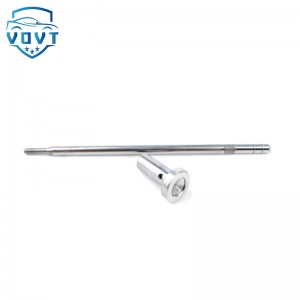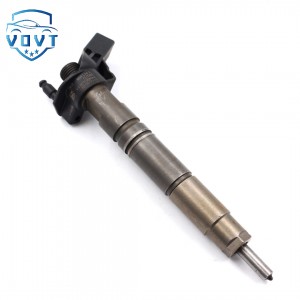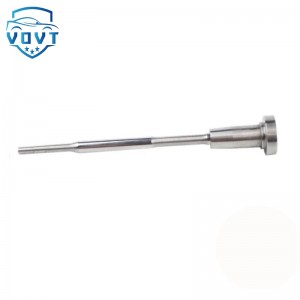Genuine Quality Diesel Injector Repair Kit for 2645K016 Injector Parts Engine Parts Auto Parts
products description
| Reference. Codes | 2645K016 |
| OE/OEM Codes | / |
| Application | Injector Repair Kits |
| MOQ | 4PC |
| Certification | ISO9001 |
| Place of Origin | China |
| Packaging | Neutral packing |
| Quality Control | 100% tested before shipment |
| Lead time | 7~15 working days |
| Payment | T/T, L/C, Paypal, Western Union or as your requirement |
Analysis and troubleshooting of fuel injector faults
Abstract
As core components of an engine's fuel injection system, the performance of the injector directly impacts engine power output, fuel economy, and emissions. With the continuous advancement of engine technology, the structure and operating principles of injectors have become increasingly complex, and the requirements for their maintenance are also becoming increasingly demanding. Injector repair kits, specifically designed to repair injector failures, include a series of key components and repair tools, providing strong support for efficient and convenient injector repair. This article details the composition, functions, and advantages of injector repair kits, as well as their application cases in various engine types and provides an outlook on their future development trends, aiming to provide valuable reference for maintenance personnel, engine manufacturers, and industry researchers.
I. Introduction
In modern engines, injectors are responsible for delivering fuel into the combustion chamber at precise pressure, flow, and spray pattern to achieve efficient combustion. However, due to long-term exposure to harsh operating environments characterized by high temperatures, high pressures, and impurity corrosion, fuel injectors are prone to various faults, such as seal failure, nozzle blockage, and needle valve sticking. These faults can lead to abnormal fuel injection, which in turn can cause engine performance degradation, such as reduced power, increased fuel consumption, and excessive emissions. Traditional repair methods often require complex disassembly and component replacement of the injectors, which is not only time-consuming and labor-intensive, but also requires high technical skills from the repair personnel. The emergence of fuel injector repair kits provides a systematic solution to this problem. They integrate all the key components and tools required for repair, follow standardized repair procedures, and significantly improve repair efficiency and reduce costs, while ensuring that the repaired injector meets engine operating requirements.
II. Fuel Injector Repair Kit Composition and Function
2.1 Seals
2.1.1 O-Rings
O-rings are common seals in fuel injector repair kits and are typically made of oil- and high-temperature-resistant materials such as fluororubber and nitrile rubber. In fuel injectors, O-rings are primarily used to seal the connections between the injector and the fuel line, and between the injector and the engine block, preventing fuel leakage. Fluororubber O-rings, for example, exhibit excellent chemical stability, maintaining excellent elasticity and sealing properties within a temperature range of -40°C to 200°C, effectively resisting corrosion from chemical compounds in the fuel. In high-pressure common rail injection systems, injection pressures can reach over 200 MPa, requiring O-rings to withstand immense pressure. Their excellent sealing properties prevent fuel leakage under high pressure, maintaining the normal operating pressure of the injection system and ensuring accurate fuel injection.
2.1.2 Gaskets
Gaskets are also important sealing components. Commonly used are metal gaskets (such as copper gaskets) and metal-non-metal composite gaskets (such as graphite-metal composite gaskets). Metal gaskets utilize their excellent thermal conductivity and pressure resistance to maintain a stable shape under high-temperature and high-pressure environments, tightly fitting the contact surfaces between the injector and the cylinder head, preventing air and oil leaks. For example, copper gaskets effectively conduct heat at engine operating temperatures, preventing seal failure caused by local overheating. Their high compressive strength also withstands the mechanical stresses generated by injector operation. Graphite-metal composite gaskets combine the self-lubricity and excellent sealing properties of graphite with the strength of metal, ensuring a secure seal while enhancing the gasket's durability. They are suitable for injector installations requiring extremely tight sealing requirements.
2.2 Functional Parts
2.2.1 Needle Valve and Valve Seat
The needle valve and valve seat are key functional components of the injector, directly controlling fuel injection. In repair kits, the needle valve is typically made of a high-strength, wear-resistant alloy, such as tungsten carbide. The needle valve's sealing cone is precision-ground to a surface roughness of less than Ra0.01μm, ensuring a tight fit with the valve seat and a good seal. When the injector is operating, high-pressure fuel pushes the needle valve upward, overcoming the spring force and opening the spray hole for fuel injection. After injection is complete, the needle valve quickly returns under the spring force, sealing tightly against the valve seat to prevent fuel leakage. The valve seat is also made of wear-resistant material, and its sealing surface matches the needle valve's sealing cone. Over time, if wear leads to a loose seal, this can cause fuel dripping from the injector, affecting fuel injection quality and engine performance. The replacement needle valve and valve seat included in the repair kit can effectively restore the injector's sealing performance and injection accuracy.
2.2.2 Springs
Springs in the injector control the opening and closing of the needle valve. Common springs include the injector spring and the return spring. The injector spring provides the opening pressure for the needle valve. Its spring constant and preload are precisely designed to ensure accurate opening and closing of the needle valve under different operating conditions. For example, during a cold engine start, a high injection pressure is required to ensure good fuel atomization, and the injector spring must provide sufficient initial pressure. During normal engine operation, the spring pressure must adapt to changing operating conditions, enabling the needle valve to achieve precise injection control. The return spring ensures that the needle valve quickly returns to its original position after injection, preventing continued fuel leakage. The springs in the repair kit are made of high-quality spring steel and undergo a heat-treated process to achieve high elastic limit and fatigue strength, ensuring stable performance even under frequent operation.
2.3 Cleaning and Repair Tools
2.3.1 Cleaning Agent
Cleaning agent is a key tool in the repair kit for cleaning carbon deposits and impurities from the injector. Common cleaning agents are specialized fuel system cleaning agents, typically containing organic solvents, surfactants, and dispersants. Organic solvents effectively dissolve carbon deposits and colloids inside the injector. Surfactants reduce the liquid's surface tension, allowing the cleaning agent to penetrate the dirt more effectively. Dispersants break up the dissolved dirt into fine particles, making it easier for the cleaning fluid to remove them from the injector. During repair, soaking the injector in a cleaning agent for a period of time, or injecting the cleaning agent into the injector at high pressure using specialized equipment, effectively removes carbon deposits and impurities from the spray hole, needle valve, and other areas, restoring the injector's smooth flow and injection performance.
2.3.2 Removal and Installation Tools
The repair kit also includes a series of specialized tools for injector removal and installation, such as injector wrenches, circlip pliers, and sockets. The injector wrenches are designed to match the injector's shape and installation dimensions, providing sufficient torque to ensure damage-free removal and installation. Circlip pliers are used to remove and install elastic components such as circlips within the injector, while sockets are used to tighten or loosen bolts and nuts of various specifications. The use of these specialized tools not only improves repair efficiency but also ensures standardized and accurate repair procedures, preventing damage to injector components caused by improper tool use.
III. Advantages of Injector Repair Kits
3.1 Cost-Effectiveness
Compared to directly replacing a new injector, using a repair kit offers significant cost advantages. Taking a commercial vehicle fuel injector as an example, a new one can cost thousands of yuan, while a fuel injector repair kit typically costs only a few hundred yuan. For fleet operators or repair shops, the widespread use of repair kits for injector repairs can significantly save repair costs. Furthermore, using repair kits can extend the overall lifespan of the injectors and reduce the waste of resources caused by premature replacement. In applications where cost control is crucial, such as agricultural machinery and small construction machinery, the cost-effectiveness of fuel injector repair kits is even more pronounced.
3.2 Maintenance Convenience
Repair kits integrate all the key components and tools required for repairs, eliminating the need for maintenance personnel to individually source and purchase individual parts, greatly simplifying the repair process. Furthermore, repair kits often come with detailed repair instructions, making them easy to follow even for relatively inexperienced repair personnel, reducing maintenance complexity. For example, when repairing a certain model of automotive fuel injector, the technician simply follows the repair manual included in the repair kit, using specialized tools to disassemble the injector, replace damaged seals, needle valves, and other parts, and then clean and reassemble. The entire repair process can be completed in a short time, improving efficiency and convenience.
3.3 Performance Restoration
High-quality fuel injector repair kits utilize reliable components that have undergone rigorous quality testing and meet injector performance requirements. During the repair process, by replacing worn or damaged parts, cleaning, and adjusting the injector, injector performance can be restored to near-new condition. Test data shows that injectors repaired with a genuine repair kit can maintain fuel injection volume deviation within ±3%, return injection pressure to the specified range, and achieve excellent atomization, effectively improving engine power output, fuel economy, and emissions. For example, after repairing an engine that had experienced reduced power and increased fuel consumption due to a faulty injector, using the repair kit to repair the injector restored engine power to normal, reduced fuel consumption by approximately 10%, and significantly reduced harmful pollutants in exhaust emissions.
IV. Application Examples of Injector Repair Kits in Different Engine Types
4.1 Automobile Engines
4.1.1 Gasoline Engines
In gasoline engines, injectors operate at high frequencies, placing extremely stringent demands on injection precision. For example, in a direct-injection gasoline engine, the injectors must deliver precisely measured amounts of fuel in a perfectly atomized state to the combustion chamber in a very short time. As vehicle mileage increases, injectors are prone to problems such as nozzle blockage and loose needle valve seals. Repair technicians use a repair kit containing a high-precision nozzle cleaning tool, high-quality seals, and a needle valve assembly. First, they use a cleaning agent and a specialized nozzle cleaning tool to remove carbon deposits and impurities from the nozzles, ensuring a clear nozzle. Then, they replace worn seals and needle valves, and adjust the injector's injection pressure and angle. After repair, the injector's injection performance returns to normal, engine jitter disappears, acceleration improves significantly, fuel economy improves, and the vehicle's overall drivability is significantly enhanced.
4.1.2 Diesel Engines
Diesel engines operate at high injection pressures, placing even higher demands on injector durability. In heavy-duty truck diesel engines, injectors often face high temperatures, high pressures, and heavy loads. For example, after long-term use, the injectors of a certain heavy-duty diesel engine developed severe wear, resulting in uneven fuel injection, reduced engine power, and severe black smoke emissions. Maintenance personnel used a repair kit equipped with high-strength needle valves, valve seats, and high-temperature seals. During the repair process, the injectors were thoroughly disassembled and cleaned to remove internal carbon deposits and impurities. Worn parts were then replaced, and the injectors were reassembled and commissioned. The repaired injectors now operate stably in the high-pressure common rail system, significantly improving fuel injection uniformity, restoring engine power to normal levels, and significantly reducing black smoke emissions, meeting the performance requirements of vehicles in heavy-duty transport and other operating conditions.
4.2 Industrial Engines
4.2.1 Generator Set Engines
In generator sets, engines must operate stably for extended periods of time, placing extremely high demands on injector reliability. After a period of operation, a diesel generator set engine used for backup power developed a fuel injector failure, resulting in unstable generator output power. Maintenance personnel used a repair kit containing high-quality springs, seals, and a precision-machined needle valve assembly. During the repair, the injector components were carefully inspected for wear, damaged parts were replaced, and the injector was rigorously tested for leaks and injection performance. After the repair, the injector resumed normal operation, and the generator set's output power remained stable, enabling it to reliably provide continuous power to electrical equipment in emergencies, ensuring the normal operation of industrial production and daily life.
4.2.2 Construction Machinery Engines
Construction machinery engines operate in harsh environments characterized by high vibration and dust, making fuel injectors susceptible to corrosion and mechanical damage. For example, in a loader engine, due to the high dust content of the workplace, the injector nozzles were frequently clogged with dust and impurities, resulting in poor fuel injection and insufficient engine power. Maintenance personnel used the specialized cleaning tools and seals included in the repair kit to perform the repair. First, use high-pressure air and cleaning agents to thoroughly clean impurities from the injector interior and the nozzle holes. Then, replace damaged seals to ensure injector sealing. After repair, the injector will function normally, engine power will be restored, and the loader's operating efficiency will be significantly improved during construction, ensuring smooth progress.
V. Development Trends of Injector Repair Kits
5.1 Material Innovation
With the continuous advancement of materials science, future injector repair kits will increasingly incorporate new, high-performance, lightweight materials. For example, new high-temperature, high-pressure, and self-healing rubber materials may emerge for seals, further improving sealing performance and service life. Nanocomposites or ceramic-based composites with increased hardness, wear resistance, and corrosion resistance will be used in key components such as needle valves and valve seats to adapt to increasingly demanding engine operating conditions and reduce component wear and failure.
5.2 Intelligence and Digitalization
Intelligent and digital technologies will gradually be incorporated into injector repair kits. Repair kits may be equipped with intelligent diagnostic tools. Using sensors and data analysis software, they can quickly and accurately detect the type and severity of injector faults and provide detailed repair recommendations to maintenance personnel. Furthermore, a digital maintenance record management system can record detailed information about each repair, including replaced parts, repair time, and post-repair performance test data. This facilitates tracking and analysis of the injector's maintenance history, providing a basis for subsequent maintenance and upgrades. Furthermore, some advanced repair kits may incorporate intelligent adjustment features that automatically adjust injector operating parameters based on the engine's real-time operating conditions, achieving more precise fuel injection control.
5.3 Customized Services
Different engine types have varying performance requirements for injectors. In the future, injector repair kits will be increasingly customized. Manufacturers will tailor repair kits based on engine model, application scenario, and specific user needs. For example, a repair kit for a high-performance sports car engine might focus on improving injector response speed and injection accuracy; whereas a repair kit for an urban bus engine with strict environmental requirements might prioritize optimizing injector emissions performance. By providing customized services, we can better meet diverse market needs and improve the applicability and repair effectiveness of repair kits.
VI. Conclusion
As a key solution for engine fuel system maintenance, injector repair kits play a vital role in ensuring engine operation, reducing repair costs, and improving repair efficiency. An analysis of their composition, functions, advantages, and application cases in various engine types demonstrates their broad application prospects and development potential. With the continuous advancement of material innovation, intelligent and digital technologies, and the in-depth promotion of customized services, injector repair kits will continue to be upgraded and improved, providing stronger support for the development of the engine industry. Whether for automotive engines, industrial engines, or other applications, injector repair kits will continue to play a vital role in the maintenance field, helping engines maintain efficient and reliable operation and driving the entire powertrain industry towards more energy-efficient, environmentally friendly, and high-performance development.





















